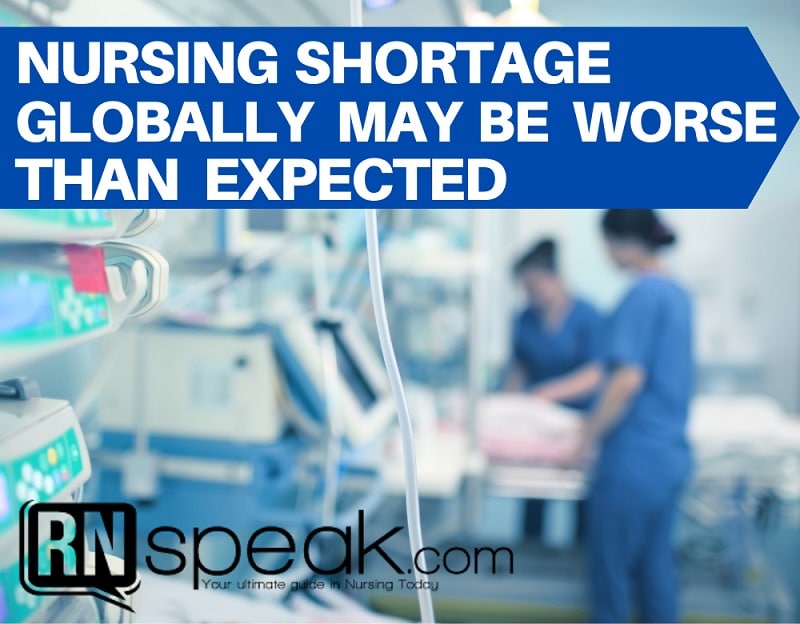The COVID-19 pandemic has significantly worsened the long-standing nursing shortage, leading to increased workloads, staffing issues, and a higher incidence of nurse burnout. The migration of nurses during the pandemic has further exacerbated the shortage, negatively impacting the nursing workforce as demographic changes occur over time.
Moreover, the effects of COVID-19 on the nursing profession have been profoundly challenging. It will take years for the statistics to reflect the reality that many nurses have left the bedside or even left work altogether due to career changes, which means that the projected nurse shortage will likely be far more severe than anticipated.
As the United States and the rest of the world battle the COVID-19 pandemic, nurses, who comprise most of the healthcare workforce, have been critical to the national response. They bear the weight of giving direct care to people affected by the new condition’s tremendous stress and difficulty. Healthcare facilities were severely understaffed even before the pandemic, and nurses were already experiencing burnout.
It is crucial to remember that no national policy currently mandates nurse staffing ratios in healthcare settings. This absence of regulation exacerbates the issues that the nursing profession and the healthcare system face.
The combination of these issues offers an uncertain outlook on nursing’s future. The nurse shortage is expected to worsen, needing immediate action to address staffing, burnout, and professional insecurity. Implementing legislation to improve nurse staffing ratios and investing in initiatives to support and retain nurses are critical steps in ensuring our healthcare system’s resilience and efficacy.
Nurse-to-Patient Ratio
Nurse-to-patient ratios vary broadly across states, and some jurisdictions have legislation to enforce these ratios. Many states use three techniques to implement these policies:
- Nurse-driven staffing committees overseeing ratios
- Specific ratios mandated by state legislation
- Public disclosure of facility staffing ratios
Hospitals that adhere to legislation proposing a nurse-to-patient ratio of one nurse for every four patients have experienced substantial benefits. It is estimated that these hospitals have saved around $720 million and the lives of 4,370 patients. A favorable nurse-to-patient ratio ensures that nurses have sufficient time to care for each patient, improving patient care and reducing hospital expenses (Trusted Nurse Staffing, June 2023).
Truth About Nursing Shortage
Nurses who experienced burnout during the epidemic, according to Galanis et al., 2021, expressed considerable emotional tiredness, depersonalization, and reduced feelings of personal success. The study also found that the COVID-19 epidemic, often known as the “great resignation,” resulted in high turnover among employed Americans. A survey of nearly 12,000 nurses conducted by the American Nurse Foundation (2022) in January 2022 revealed that 89% of respondents said their organization was facing a staffing shortage, and 60% of respondents under the age of 35 reported experiencing an extremely stressful, violent, or traumatic event as a result of COVID-19.
The COVID-19 outbreak exacerbated the long-standing national nurse shortage. According to one study, the United States will face a shortage of up to 450,000 bedside nurses during the next two years. The situation will inevitably be remedied because there is a lot greater need for nurses than there are available. One element contributing to the nursing shortage is migration to other countries. Leading nurses worldwide have left the healthcare system due to inadequate pay, hazardous working conditions, a lack of career growth, and professional prestige and autonomy.
Additionally, due to a shortage of nursing teachers and job possibilities that offer higher pay, some nursing schools in some countries can only accommodate a few students. Between 1995 and 2001, the number of nursing school graduates who took the exam to become registered nurses in the United States dropped by 26%. According to their list of most prevalent causes, which differs by country, the shortage will affect 20% of the world’s population by 2025 due to an aging population and an upward trend in hospitalized patients who are more seriously ill. The creation of novel techniques, therapies, and technological applications considerably impacted this. Finally, some illnesses are rapidly spreading diseases.
The Effect of Migration on the Shortage
The severe nursing shortage has resulted in increased overseas recruitment of nurses, posing substantial retention and migration issues. During healthcare crises, nurses are frequently the ones who suffer the most. Member states should seek assistance in creating measures to solve the global nursing workforce shortage, considering migration’s impact on economically disadvantaged and least developed countries.
Nursing Shortage by States
According to a State of Nursing survey, 91% of nurses believe a nursing shortage exists. According to a study, the existing and predicted nursing shortage is better. While the 2020 HRSA Nursing Workforce Projections report estimates that 98% of overall nursing demand will be met by 2030, the methodology supports a lower estimate of 94%, with a need for an additional 206,553 nurses by 2030.
In 2030, 42 out of 50 states may face a shortage of nurses, with North Dakota, Colorado, Texas, Florida, and Nevada experiencing the highest percentage of unmet nursing demand (Lysons, Jessica, 2023). In contrast, eight states are predicted to have a surplus of nurses. Vermont, Maine, Rhode Island, West Virginia, Alabama, Pennsylvania, Connecticut, and New Hampshire are among these states.
The Health Resources & Services Administration (HRSA) plays a vital role in serving communities with the most significant healthcare needs. Their initiatives cater to low-income individuals, people living with HIV, pregnant women, children, parents, rural communities, transplant patients, and the medical workforce. However, the calculations suggest that the nursing shortage may be more severe than projected by the HRSA. By 2030, there could still be a demand for an additional 206,553 nurses, representing 94% of the overall demand.
Nursing is Caring
Despite their dissatisfaction with the workplace, nurses agree they must leave the chaos behind to seek better opportunities. They continue to provide high-quality care to patients while upholding their dignity. Nurses are considered one of the most ethical and honest professions as professionals who deal with lives and directly impact patients. At the community level, nurses are vital in providing healthcare, teaching patients about nutrition, hygiene, preventive care, and illness treatment. By delivering exceptional care to families and individuals, nurses contribute to overall well-being and improvement in quality of life.
Nurses are an essential part of the healthcare workforce in the United States and around the world. According to a Gallup poll conducted in January 2020, nurses continuously ranked first in honesty and ethics among all occupations. The recognition has been given for the past 18 years. Nurses have also suffered the brunt of the COVID-19 pandemic’s direct impacts, working diligently on the front lines in hospitals and long-term care facilities.
To efficiently meet the needs of the nursing workforce, the profession must monitor demographic shifts, such as racial and ethnic distributions, and adapt to changes in the scope of practice and nurse migration. The growth of the nurse licensure compact and its impact on labor distribution among states should be thoroughly investigated. Additionally, efforts should be made to identify the services nurses can provide to fulfill the population’s needs.
The Utah Nurse, Workforce Information Center, has used data from nurse workforce supply surveys to track progress toward national targets. The Future of Nursing report highlights the importance of improved data collection and information infrastructure for effective workforce planning and policymaking. Nursing has undergone significant shifts in the last decade, including improved rules that have resulted in improved access to healthcare, a highly skilled nursing workforce, more nursing leadership, and greater diversity within the field.
Nursing Shortage Solutions
Nurses deserve well-funded programs that equip them with the tools to do their duties safely, with dignity, and compassion. The steady drop in recruitment to the field, along with the failure of the global public health community to address this trend, poses a threat to the functioning of many health systems.
Nurses serve as vital healthcare team members, working as providers, advocates, educators, and administrators. They are known for their honesty, ethics, and exceptional care for patients and their families and serve as the backbone of healthcare systems. Despite a nursing shortage, hospitals that successfully attract and retain nurses have qualities such as supportive leadership, professional practice, and a positive work atmosphere associated with improved patient outcomes. Effective nurse administrators show their employees innovation, proactivity, and support by encouraging open communication and promoting career development. When nurses are granted autonomy and control over their professional practice, they feel empowered, strengthening their professional relationships with colleagues.
Healthcare executives are responsible for implementing evidence-based interventions to improve and restore the psychological health and well-being of the nursing workforce. By prioritizing the psychological well-being of nurses, organizations can create a supportive environment and ensure their professional success.
Nursing, a noble profession, is at the foundation of the healthcare industry. Nurses not only offer physical care for patients, but they also give important emotional support. This career necessitates steadfast dedication, a high tolerance, and selfless dedication to humanity. Nurses work tirelessly to meet the needs of others, guaranteeing the well-being of their coworkers and maintaining positive working relationships. The juggling performance they execute is quite admirable. Nurses are important to the healthcare support system, so it is only possible to consider a society without them. The global nursing shortage indicates their significant contributions even more. It is an honor for these noble individuals to be recognized in the medical community.










